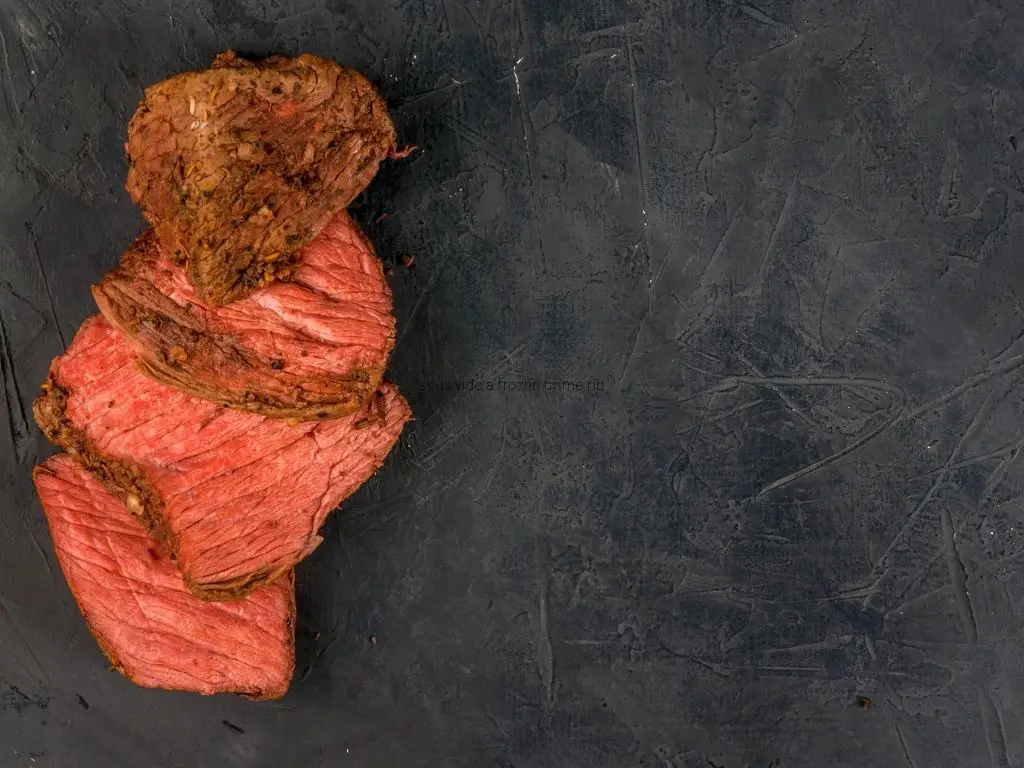There are a few common reasons why your sous vide steak may turn out chewy and tough rather than tender:

Sous Vide Products I Use Every Day
As an Amazon affiliate, I earn from qualifying purchases.
Last update on 2025-03-03 / Affiliate links / Images from Amazon Product Advertising API
Incorrect Temperature
Cooking the steak at too low of a temperature is one of the main culprits of a chewy texture. The collagen and connective tissue will not adequately break down at temperatures under 130°F. While a very high temperature above 160°F can also cause meat to seize up and toughen. The ideal temperature range for tender steak is 130-140°F.
Inadequate Cooking Time
Cooking times that are too short will prevent the collagen and connective tissue from fully transforming into tender gelatin. Thick cuts of meat often need to cook for many hours, sometimes up to 72 hours for extreme tenderness. Refer to time and temperature charts to determine the ideal cooking duration.
Poor Quality Meat
Tough cuts of meat with a lot of collagen and connective tissue may never become tender, no matter how long they cook sous vide. It is best to choose tender cuts like ribeye, strip, or tenderloin. Well-marbled steaks with adequate intramuscular fat will also be more tender.
Inappropriate Seasoning
While seasoning is important for flavor, some ingredients can toughen the meat. Too much salt can cause steak to tighten and seize up, becoming chewy. Acidic marinades that are left on too long can start to cook the meat and give it a rubbery texture.
Improper Searing
An inadequate sear will fail to caramelize the exterior of the meat and develop those flavorful browned bits. But overcooking during sear can result in a tough outer layer. Use high heat for a brief time just until browned.
How to Prevent a Chewy Sous Vide Steak
Follow these steps to ensure your sous vide steak comes out perfectly tender from edge to edge:
1. Choose the Right Cut of Meat
Pick a naturally tender cut like ribeye, New York strip, filet mignon, or sirloin. Tenderloin and loin cuts will generally be the most tender. Opt for well-marbled steaks for added moisture and tenderness. Grass-fed beef has less fat so may become chewier.
2. Use the Correct Temperature and Cooking Time
Refer to reliable sous vide time and temperature charts. For medium-rare doneness, cook fattier ribeyes and strips at 131-134°F for 2-4 hours, and lean tenderloins at 133-140°F for 1-4 hours depending on thickness. Thicker cuts need more time.
3. Season Your Steak Properly
Lightly salt your steak before vacuum sealing, about 1/4 tsp per pound. Pepper and other seasoning can be added after cooking. Avoid marinades and excessive salt which could start curing the meat.
4. Sear Your Steak Correctly
After cooking sous vide, pat your steak very dry. Get your skillet or grill extremely hot. Quickly sear the steak 30-60 seconds per side just until nicely browned and caramelized. Do not overcook.
5. Rest Your Steak After Cooking
Let your steak rest at least 5 minutes before slicing to allow juices to redistribute evenly throughout the meat. This prevents excess moisture loss as you cut into it.
Conclusion: Tips for Achieving Tender Sous Vide Steak
Perfectly cooked sous vide steak is tender enough to cut with a fork. To avoid chewing on rubbery meat, remember these tips:
- Cook at the right temperature (130-140°F for medium rare)
- Allow ample time for collagen to break down
- Pick high quality, well-marbled cuts
- Season minimally before cooking
- Quickly sear over very high heat
- Let steak rest before serving
Mastering these techniques will give you fork-tender sous vide steak every time. Sous vide cooking offers unparalleled control for getting steak cooked precisely to your preferred degree of doneness while still being tender. Follow this guide and you’ll be guaranteed moist, buttery-soft steak that melts in your mouth with delicious beefy flavor in every bite.


![IMPRESA [10 Pack] Sous Vide Magnet Weights for Keeping Bags Submerged – Sous Vide Accessories to Stop Floating Bags & Undercooking – Weighted Magnets for Containers](https://m.media-amazon.com/images/I/41zHpl8G2lL._SL160_.jpg)

